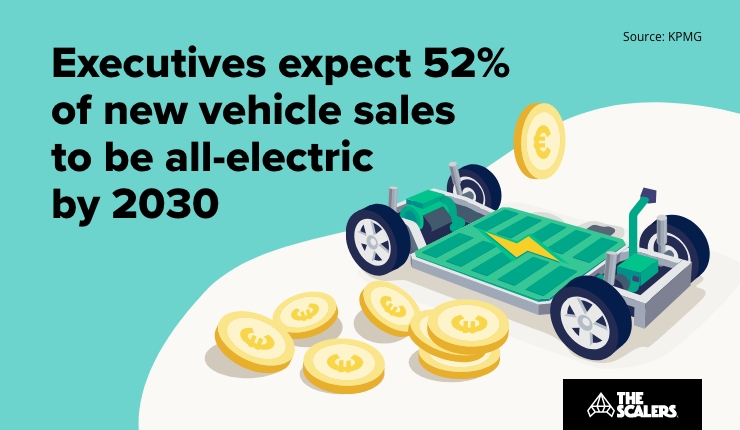The automotive industry is becoming more digitised as companies strive to create new technologies that can provide consumers with a better quality of life. This shift in lifestyle and technology has resulted in many benefits for the industry and consumers alike. Digital transformation in automotive has changed how a car is built, serviced by companies, and driven by its customers.
How digital transformation in automotive has led to the growth of autonomous driving
The development of autonomous driving technology has allowed cars to begin to drive themselves. Despite years of debate over the practicality of the technology, manufacturers have only recently begun implementing it.
The first major auto manufacturer to bring this new technology to market was Tesla. The Tesla Autopilot feature caused a media frenzy, with Tesla owners eager to try the latest technology. There were and continue to be critics of the feature, however the evidence is clear that the technology provides safer conditions than being driven by a human.
Tesla recorded one crash for every 4.31 million miles driven using Autopilot technology. Meanwhile, they recorded a crash every 1.59 million miles for drivers without Autopilot technology. Meanwhile, more and more traditional automotive companies such as BMW are creating their own in-house autonomous driving departments. But what does all this mean for the future of the human workforce? Will smart factories and technologies like Autopilot reduce the number of jobs for skilled workers?


A recent MIT study actually states that because of the rise in these digital technologies the world will see an enormous number of high-level positions appear over the next 20 years. In fact, the study claims that the development could create approximately 300,000 dedicated positions! Autonomous driving will be a significant factor in this increase. These new jobs will involve the design and production of autonomous vehicles and their maintenance.
Fully autonomous driving technology is still in the early stages of development. Some critics are not that hopeful of the technology’s development and claim that it is decades away from being perfected. This might be true, however, we already see autonomous vehicles on the market capable of driving without human input.

Don’t get left behind in the shift to digital business
DOWNLOAD INFOGRAPHICMultiple tests have been performed on autonomous technology, and they have proven to work very well. However, a significant amount of research still needs to be done before the technology can be applied everywhere.
As previously mentioned, Tesla has made significant progress in the autonomous industry. In 2019, it upgraded its full self-driving hardware from HW2.5 to HW3. It’s now said to have twice the computing power as before, putting it years ahead of the competition. This advancement is in large part due to the extensive machine learning that has gone into its development, allowing cars to drive around obstacles, and stop before they reach pedestrians.
Continual training via machine learning will lead to huge leaps forward for the automotive industry. This can enable autonomous vehicles to learn what actions to take in specific conditions.
The need for data security and protection in the automotive industry
As digital transformation in automotive increases, so does the amount of data produced. With this increase in data comes a rise in the need for companies to protect it from cyber threats.
Cybersecurity is a growing concern within the automotive industry. The most harmful threat to a company is often a cyberattack. Hackers can steal personal information and any other type of data a company holds. Unfortunately, this transformation has made the automotive industry even more vulnerable to hackers.

Auto manufacturers are working hard to protect their data systems from hackers by heavily investing in security measures, like firewalls. Vehicle manufacturers have implemented many layers of security to prevent cyberattacks on their systems and the theft of their valuable information. This includes using encryption to keep confidential data secure.
All this has been done to protect in-depth financial information and digitised vehicle assembly lines from being compromised. The stakes are high for manufacturers, but they understand that the amount of data they hold is extraordinarily valuable. Intelligent vehicles collect a lot of data, and the cybersecurity measures used to protect this data are significant.

Can’t find the skills you need at home? Stop searching and start scaling
LEARN MOREThe automotive industry is among the most data-driven industries in the world. Autonomous vehicles are the main target of these types of attacks. The amount of data they collect is vast and is valued by hackers. The automotive industry needs to take a more proactive approach to cybersecurity measures to protect the information they hold.
With the amount of data being produced, companies need to store their data in a centralised location. This is unlike many other industries that use cloud computing services. This is an essential and crucial feature of the vehicle. The vehicles have to be connected so they can talk to one another. This is essential for the vision of self-driving vehicles.
An autonomous vehicle needs to communicate with other vehicles and pedestrians. This is vital for it to function properly. The entire vehicle has to be connected for it to work. Otherwise, it could only communicate with other vehicles or pedestrians.
A car produces an extraordinary amount of data, requiring central storage. Building a centralised data storage system is the most efficient way to keep data safe. If a company were to use cloud computing services, their computer would not be able to handle the massive amounts of information that would be produced by their vehicles.
Mobility-As-A-Service (MaaS) as part of digital transformation in automotive
The growth in digital transformation in vehicles has led to the incorporation of Mobility as a service (MaaS) — the next logical step in the evolution of transportation. It enables motorists, manufacturers, and owners to use, share, and manage their vehicles seamlessly without ownership or even traditional operating agreements.
With the rise of digital transformation in automotive, automakers want to speed up the adoption of autonomous vehicles. The introduction of MaaS is an effective method to achieve this goal, allowing automakers to increase consumer interest and profitability of their vehicles.

MaaS will change how people live by connecting vehicles to one another. A lot of innovation has gone into the development and deployment of MaaS, to eventually create extremely affordable transportation to all users.
The introduction of MaaS will also help people save money on transportation costs because it will allow people the freedom to choose when and how they would like to commute. The overall goal of MaaS is to provide all the benefits of autonomous vehicles without the hassle of owning them. This will give users more convenient ways to travel.

How can The Scalers help?
The Scalers help automotive manufacturers achieve their digital transformation goals by building offshore teams of software developers that can implement the right technologies needed to make autonomous driving, cybersecurity, MaaS and other technical solutions a reality.

How we helped Preqin establish a 450+ person global R&D centre in India
DOWNLOAD CASE STUDYThe Scalers can:
- Source top engineering talent
- Build robust tech teams
- Scale your company without limits
- Run your operations
Digital transformation in automotive – conclusion
Automotive manufacturing will be a critical necessity for the future of mass-produced passenger vehicles. The Internet of Things (IoT) and advanced digitalisation will improve quality and reduce production costs through data analytics applied to manufacturing processes and products.

















